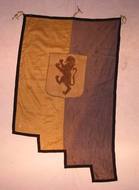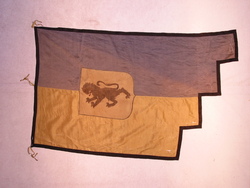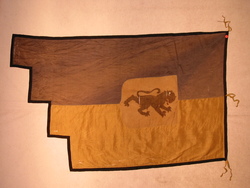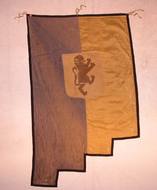A beautiful banner made for use during the Corteo Storico in Siena.
This hand sewn silk, flag is really a banner designed to hang vertically from a building in the Piazza del Campo in Siena during the Corteo Storico; a magnificent pageant which precedes the Palio race. This flag does not conform to a known "Contrada" coat of arms; but it may be a stylized panther and therefore indicative of the Pantera Contrada (The Panther District). Pantera is situated at the western edge of the city. Traditionally, its residents were grocers and chemists. Its symbol is a rampant panther and its colors are red, blue and white.
The parade prior to the race makes a magnificent spectacle, the banners of which are similar to ones held by those viewing the parade or decorating surrounding buildings. In addition to the guilds, districts and "thirds", Siena formerly had parishes, dependencies, and castles with their own flags. This flag is probably from one of the latter groups. Its shape matches banners hung on the facades of buildings and its heraldic design does not correspond to any of the banners of the thirds, Contrada, or guilds. The flag has faded, but seems originally to have consisted of equal vertical stripes of yellow and blue with a central white shield bearing a panther depicted in its natural colors.
The flags carried in the Palio procession are not only waved back and forth, they are tossed in the air. Their staffs are short, with a knob at the end for the standard-bearer to grasp. Long practice makes it possible for the men to twirl the flags, throw them back and forth, and spin them through the air with great dexterity. Similar flag teams with their own national customs exist in Switzerland, the Netherlands, and the United States.
The Palio was originally a flag mounted on a carrocio (ox-drawn cart) with an altar; and constitutes the prize won in the horse race. Conducted annually in Siena the event attracts visitors and spectators from around the world. Over time, Palio has come to refer to the race itself and a cultural tradition that has developed into a tourist attraction which draws thousands. The teams of jockeys are from each of the 17 Contrada or districts of Siena. Each Contrada team dresses in elegant and colorful uniforms inspired by the ones worn in the 16th century. The first horse race is believed to have been run in 1632 to honor Grand Duke Ferdinand II of Tuscany.
This Palio flag was formerly part of the collection of the M.H. de Young Museum. Founded in 1895 in San Francisco's Golden Gate Park, the de Young Museum was San Francisco's first museum. It was a great success from its opening and has been an integral part of the cultural fabric of the city and a cherished destination for millions of residents and visitors to the region for over 100 years.
Michael Henry de Young ,1849 -1925, was an American journalist and businessman who owned and published the San Francisco Chronicle. He used his wealth to further his eclectic tastes and accumulated a collection of immense variety, and such diverse objects such as sculptures, paintings, flags, polished tree slabs, paintings, objet d'art, jewellery, a door reputedly from Newgate Prison, birds' eggs, handcuffs and thumbscrews, and a collection of knives and forks.
This banner almost certainly originates from before 1870. It is made of silk, hand-stitched and the panther is painted on. It also features ribbons to be used to attach it to a staff. See ZFC0225 and ZFC0414.
Provenance:
• Made in Siena, Italy.
• Acquired by Michael Henry de Young.
• Conveyed to de Young Museum, San Francisco, CA.
• Sold via Butterfield & Butterfield Auctions in San Francisco, CA, to the Zaricor Flag Collection, 1997.
ZFC Significant Flag
Sources:
History of the de Young Museum, de Young, Fine Arts Museums of San Francisco, 17 November 2011: http://deyoung.famsf.org/about/history-de-young-museum
THE PALIO HORSE RACE, ilpalio.org, 17 November 2011: http://www.ilpalio.org/palioenglish.htm
Contrade of Siena, Wikipedia, 17 November 2011, from: http://en.wikipedia.org/wiki/Contrade_of_Siena
Palio di Siena, Wikipedia, 17 November 2011, from:
http://en.wikipedia.org/wiki/Palio_di_Siena
Image Credits:
Zaricor Flag Collection
































